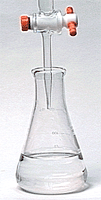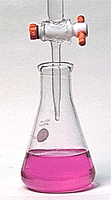2 NaOH + H2SO4
Na2SO4 + 2H2O
In a titration, a known volume of a solution of unknown concentration is reacted with, or titrated by, a known volume of a solution of unknown concentration. By knowing the titration volumes and the mole ratio in which the solutes react, the concentration of the second solution can be calculated. The method used is similar to that used in Examples 11.8 and 11.9. The solution of unknown concentration may contain an acid (such as stomach acid), a base (such as ammonia), an ion (such as iodide ion), or any other substance whose concentration must be determined.
There are several requirements for analytical titrations:
Let us discuss these requirements as they apply to a particular titration, that of a solution of sulfuric acid of known concentration with a sodium hydroxide solution of unknown concentration. The balanced equation for this acid-base reaction is:
2 NaOH + H2SO4
Na2SO4 + 2H2O
Sodium hydroxide ionizes in water to form sodium ions and hydroxide ions; sulfuric acid ionizes to form hydrogen ions and sulfate ions. The reaction between hydroxide ions and hydrogen ions is rapid and complete; thus, the second requirement for an analytical titration is met.
What clear-cut change in property will occur when the reaction is complete? Suppose the sodium hydroxide solution is slowly added to the acid solution. As each hydroxide ion is added, it reacts with a hydrogen ion to form a water molecule. As long as unreacted hydrogen ions remain in solution, the solution is acidic. When the number of added hydroxide ions exactly equals the original number of hydrogen ions, the solution becomes neutral. If any extra hydroxide ions are added, the solution becomes basic. How will the experimenter know when the solution becomes basic? In Section 5.7D you learned about organic compounds called indicators that have one color in acidic solutions and another in basic solutions. If such an indicator is present in acid-base titration, it changes color when the solution changes from acidic to basic. Phenolphthalein is an acid-base indicator that is colorless in acidic solutions and pink in basic solutions. If phenolphthalein is added to the original sample of sulfuric acid, the solution is colorless and will remain so while hydrogen ions are in excess. After enough sodium hydroxide solution has been added to react with all of the hydrogen ions, the next drop of base will provide a slight excess of hydroxide ions and the solution will turn pink. Thus, there will be a visible and clear-cut indication of the occurrence of the endpoint. Table 11.4 lists three indicators that could be used in acid-base titrations.
| Indicator | Color in acid | Color in base |
|---|---|---|
| phenolphthalein | colorless | pink |
| methyl orange | red | yellow |
| bromothymol blue | yellow | blue |
The requirement to measure accurately the volumes of solutions used is met by the use of volumetric glassware- in particular, burets - to measure the volumes of the solutions. Recall from Section 2.2 that the precision of a buret is one part per thousand. Figure 11.4 shows a typical titration setup.


| FIGURE 11.4 A typical acid-base titration: (a) An exact volume of a solution of known concentration of acid is measured into flask. A few drops of phenolphthalein indicator are added. (b) The solution containing sodium hydroxide in an unknown concentration is added until a faint pink color is visible for a few seconds. |
Data and calculations for a typical acid-base titration are shown in Table 11.5 Notice that three trials were run - a standard procedure to check the precision of titration.
Titration reactions are not always acid-base reactions. They may be oxidation-reduction reactions, precipitation reactors, or combination reactions. The endpoint may be determined by a change in color of an added indicator or by a change in color of the solution when the reaction is complete. In other titrations, the endpoint may be marked by a change in electrical conductivity of the reaction mixture, by the formation of a precipitate, or by a variety of other means.
|
||||||||||||||||||||
| Data Molarity of H2SO4: 0.108 M = 0.108 mmol/mL |
||||||||||||||||||||
|
||||||||||||||||||||
|
||||||||||||||||||||
|
||||||||||||||||||||
| * The first three factors in the equation give the millimoles of H2SO4 used. Dividing by the volume of acid used gives the molarity (mol/L). The 1 in the last factor is a dimensionless number. | ||||||||||||||||||||
|
Example: three 25.00 mL samples of sulfuric acid solution of unknown concentration were titrated to a phenolphthalein endpoint with 0.129 M potassium hydroxide solution. the buret readings for each of the trials were as follows:
Calculate the molarity of the sulfuric acid solution. Solution The solution to this problem should be set up in the form of Table 11.5. Equation 2 KOH + H2SO4 Data Molarity of KOH: 0.129 M ( 0.129 mmol KOH/mL solution)
(These data are obtained by subtracting the buret reading given in the body of the problem.) Average volume of 0.129 M KOH used: 33.14 mL Arithmetic equation Answer |